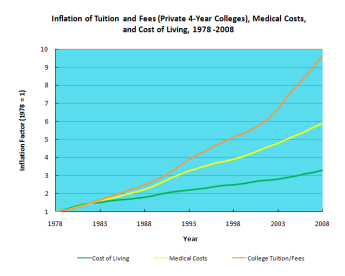
Within the past ten years, a college degree requirement has become more common within the job search process. According to the U.S. Department of Education, by the year 2020, nearly two thirds of job openings will require postsecondary education or training.
With more people now being encouraged to attend college, the price is also increasing. The United States is predicted to have the highest proportion of college graduates in the world by the year 2020.
With prices going up, parents are finding more difficulty in helping fund their children’s higher education. Students who are determined to get their degrees often are forced to find alternate ways of paying.
“I did not save one time for college,” senior history and secondary education major Treci Butler said. “Out of my entire costs to attend Cabrini University, I have about $28,000 in loans.”
Taking out student loans is typically the norm for almost every college student paying for higher education on their own. Between 1992 and 2012, the average amount owed by a typical student loan borrower who graduated with a bachelor’s degree more than doubled to a total of nearly $27,000.
FASFA, the Free Application for Federal Student Aid, also is a resource for students who need help in funding their college education. Students apply every year and are rewarded based off of their family income, ethnicity, hometown and more factors.
Cabrini’s financial aid office has counselors that work closely with students to help them through the process.

“Our role in the financial aid office is to take your FASFA information and prepare a financial aid package for you using all types of federal state or institutional aid that you may be eligible for,” Director of Financial Aid Thor Kress said. “So we put it all together in one financial aid package delivered out to the student that shows them what types of grants, scholarships or loan funding that they might be eligible for.”
College has never been more expensive and it is likely only going to rise. In the United States current government administration, the GOP Tax Bill will make it harder for students to pay for college and to pay back their loans.
Every college student is different when it comes to their financial aid status. Many who pay for their own education will have multiple part time jobs and/or will commute to their school to avoid paying room and board fees. The typical college experience of living in dorms and graduating in no-more than four years is no longer the norm.
“I currently work as a waiter/bartender at the Oaks Ballroom in Glenolden, Pa.,” junior writing major Johnny Myers said. “I also work as a student ambassador and a classroom coach at Cabrini. I didn’t save much for college, as I always had the expectations I’d be paying through loans.”
The current nation default rate, or amount of borrowers who fail to remain current on their loans, is around 11.5 percent in the United States. Cabrini has a 95 percent rate of students who obtain full time job positions or attend graduate school 10 months or less after graduating.
“Cabrini[‘s default rate has] been 4 to 5 percent for three years in a row,” Kress said. “So we have a very low default rate, which I think speaks to the quality of the education and the value that you get, because if your graduates are able to pay their loans successfully, that indicates that they’ve secured some type of employment— some type of earnings that allows them to do that.”
Looking into the future of higher education, it seems that necessity and cost are rising hand in hand. Even after adjusting for inflation, the tuition of public four year colleges has more than doubled over the last three decades, according to the Department of Education.
“Colleges are way overpriced,” Butler said. “We do not know where the money is going. Professors seem underpaid, students are never satisfied, so I am confused as to why we are all paying these crazy rates for college. The good part is that if you prove yourself, you can be rewarded through scholarships and grants.”
Video by Sydney Lynch



